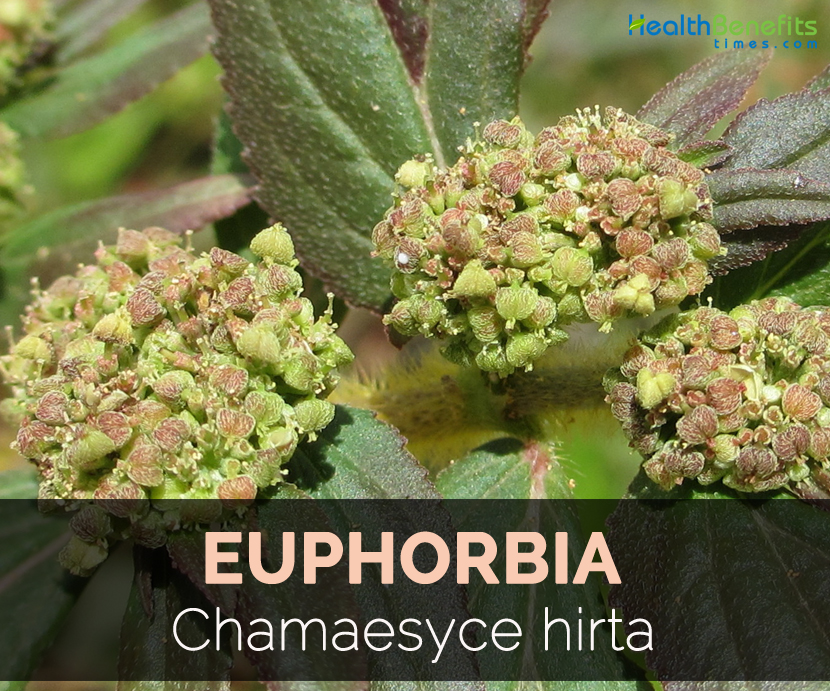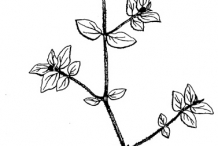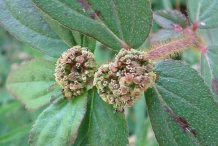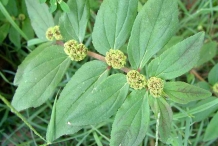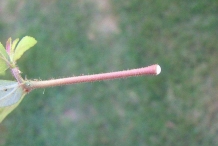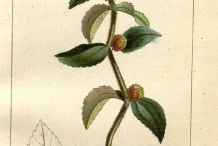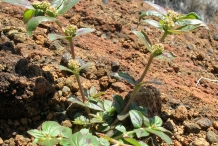| Euphorbia Quick Facts |
| Name: |
Euphorbia |
| Scientific Name: |
Chamaesyce hirta |
| Origin |
It is inherent to Southern USA, Central America, Mexico, tropical South America and Caribbean. |
| Health benefits |
Boost immune, Lowers inflammation, Eliminate intestinal worms, Respiratory problems, Maintains sexual health |
Chamaesyce hirta is a strange and herbaceous plant which is considered to be inherent in India and has become pantropical species. This herb is hairy and measures 2′ long which bears flowers and oblong leaves that appears on side of the stem. The plant bears yellow fruits that resemble capsules along with reddish seeds. Being an annual plant, it blooms and produce fruits during the year. Every part of the plant possess a milky latex. It has the chemical composition of sterols, tannins, alkenes, glycosides, triterpenoids, alkaloids, quercetin, choline and shikimic acid. It donot prefer winters. The flowers are monoecious which refers that both sexes of flowers cannot be present in the same plant. Pollination occurs by insects. It does well in well-drained soils and requires dry or moist soil.
Due to the presence of exclusive chemical structure, it is used for medicinal uses. Traditionally, it has been used for thousands of years for the treatment of health ailments. This plant is widely spread and introduced which is prevailing in sub-tropical and tropical environments of Australia. It is commonly found in waste areas, disturbed sites, gardens, roadsides, bare areas, open grasslands, lawns, footpaths, pastures and crops. It occurs as natural vegetation in Northern Australia and considered as environmental weed in Northern Territory, Western Australia and Northern Queensland.
History
It is widely found in the topcial regions of the world. It is introduced by the Americas to other tropical regions. It is inherent to Southern USA, Central America, Mexico, tropical South America and Caribbean. Probably, this species was introduced to this country; it is sometimes regarded to be native to eastern or northern Australia.
It is naturalized widely in the tropical regions that also includes eastern and south eastern Asia such as Singapore, Vietnam, Malaysia, Thailand, Indonesia, the Philippines, Cambodia, Papua New Guinea, China, Japan, Taiwan, New Zealand, Mauritius and in the Pacific islands such as American Samoa, Niue, Palau, Nauru, the Marshall Islands, New Caledonia, Hawaii, Kiribati, French Polynesia, Guam, Fiji and Galápagos Islands.
Plant
This annual herb measures about 30-60 cm high with few branched. It has fibrous root of about 3-5 mm. Stems are ascending to erect which is 3 mm thick and is branched from middle or above with yellow to brown multicellular hairs. Male flowers have 4-5 red anthers. Female flowers have three angular ovary, short pedicle, slightly two lobed stigma, sparsely pilose and exserted from involucre. The fruits are three angular capsules that are smooth, shorly pilose and 1-1.5 × 1-1.5 mm with peduncle of about 1.5 mm. It has tegragonal to subglobose seeds that are reddish with transversely furrowed sides and measures 0.7-0.9 × 0.4-0.5 mm in size. The caruncle is absent.
Leaves
The leaves are triangular, opposite, caduceus of about 0.8-1.7 mm having petiole of 1-3.5 mm. Leaf blades are long elliptic, lanceolate to oblong or ovate to lanceolate measuring 10-50 × 3-16 mm, green to red adaxial with purple blotch along midrib.
Health benefits of Euphorbia
Euphorbia belonging to Euphorbiaceae family is widely distributed in hotter parts of India and could be found in waste places along roadsides. This plant is used in traditional medicines for the treatment of gastrointestinal disorders, respiratory diseases, pulmonary disorders, wound healing, tumors, urinogenital disorders, lactation in women etc. It possess antioxidant, anti-inflammatory, anti-diabetic, anti-tumor, anti-allergic, free radical scavenging, anti-anaphylactic, analgesic, sedative, antioxytic, anti-diarrhoeal, anti-arthritic, anti-thrombocytopenic, spasmogenic, diuretic, immune stimulatory, antihelmentic, antiviral, antimicrobial, antimalarial, larvicidal, andimolluscidal properties. Each part is used for treating various health ailments. The milky sap is used to heal cracked lips whereas the leaves are useful in treating skin ailments. Flowers are useful for eye problems. Other benefits are discussed below:
- Boost immune system
Euphorbia has a great impact on immune system in various ways but it is quite popular for treating eye infections. The flowers are used to make a decoction that helps to soothe eye infections as well as lowers the signs of conjunctivitis. It is still used in these present days.
- Lowers inflammation
This herb helps to neutralize toxins and lowers inflammation caused due to snake bite.
- Eliminate intestinal worms
Euphorbia acts as an anthelmintic that assist in eliminating intestinal worms and parasites by preventing the problems that these foreign bodies causes.
- Respiratory problems
Euphorbia is an aid for respiratory problems due to its anti-inflammatory properties that makes it effective for asthma, bronchial irritation, chronic coughing, sore throats and bronchitis.
- Maintains sexual health
Euphorbia possesses antibacterial and antiviral properties that make it effective for the treatment of urinary tract infections and veneral diseases.
- Promotes fertility
Euphorbia acts as a sexual stimulant in males that assists in enhancing libido and fertility. It is a perfect solution for those people who want to enhance their sex drive and start a family. It also prevents the chances of premature ejaculation.
- Intestinal health
Euphorbia supports gastrointestinal health with the elimination of intestinal worms and parasites along with the symptoms of dysentery and diarrhea. It soothes gut walls and restores bowel movements and prevents discomfort and pain.
- Healthy skin
Apply the salves made with Euphorbia to the skin on wounds, boils, burns, rashes and marks. It enhances the healing process by stimulating the regrowth of new cells and flow of blood. It has antioxidant properties that promote skin health. It lowers the appearance of wrinkles, sun damage and eliminates signs of aging.
Traditional uses
- Euphorbia is used for treating respiratory problems such as catarrh, bronchitis, asthma and laryngeal spasm.
- It is also useful for intestinal amoebiasis.
- As it possesses anti-inflammatory properties, it is applied to snakebites and insect bites.
- The infusion made from the plant acts as a febrifuge, cholagogue and as an aid for colds, intestinal afflictions, flatulence.
- Add ghee to poultice to treat rheumatism and filarial.
- In French Guiana, an infusion made from leaves are used as cholagogue and used to cure diarrhea.
- Leaves either bruised or chopped is useful for abscesses and adenitis.
- The stem is used for bronchitis, asthma and other lung problems.
- It is useful for intestinal amoebic dysentery as well.
- Decoction made from plant is used to treat enteritis, dysentery, athlete’s foot and skin problems.
- It is also used for treating syphilis.
- Warts could be eliminated by applying sap.
- It relaxes bronchioles and has depressant activity on respiration and heart.
- It is used to eliminate worms in children.
- This herb is also used for genital complaints and gonorrhea.
- Boil 1 bottle of water by adding 15-30 g of fresh and washed herb for about 15 minutes. Then filter it and drink the portions for treating amoeba dysentery.
- An anti-amoeba tea could be made by mixing a handful of each guava leaves, mango leaves and asthma weed. It is effective for cholerea, bacillary dysentery and amoeba dysentery. It should be mixed with one liter of water and boil it and leave it for 30 minutes. After filtering, drink it throughout the day.
- For treating intestinal cramps, kidney infection and urinary tract infection, intake the infusion.
- For intestinal worms, boil one liter of water with asthma weed without roots and pawpaw leaves for about 15 minutes. Drink it.
- The decoction made with root of Euphorbia helps to enhance lactation in nursing women.
- It is useful for menstrual problems, kidney stones and venereal diseases.
- Flowers acts as an aid for eye infections as well as inflammations such as pinkeye and conjunctivitis.
- In Philippines, it is used as a treatment for dengue.
- Use the crushed leaves to wound that helps to stop bleeding and speeds up the healing process of wounds, pimples and boils.
- The root decoction is used for constipation and enema.
- Gargle with the decoction for the treatment of mouth ulcers and thrush.
Precautions
- Avoid prolonged ingestion.
- Avoid its use by lactation and pregnant women.
- It may cause allergic reaction and skin irritation.
- Sap is harmful for ingestion as it is highly irritant and causes photosensitive skin reactions as well as severe inflammation.
- Allergic reactions, vomiting and nausea are its adverse effects.
- Consult the doctor before adding it to the health plan.
References:
https://www.itis.gov/servlet/SingleRpt/SingleRpt?search_topic=TSN&search_value=28081#null
http://davesgarden.com/guides/pf/go/66130/
http://www.pfaf.org/user/Plant.aspx?LatinName=Euphorbia+hirta
http://herbs.indianmedicinalplants.info/index.php/sanskrit-names-of-plants/53-2012-03-14-06-51-26/761–euphorbia-hirta-
https://keyserver.lucidcentral.org/weeds/data/media/Html/chamaesyce_hirta.htm
http://www.cabi.org/isc/datasheet/21355
https://www.anamed-edition.com/en/euphorbia-hirta.html
http://www.alwaysayurveda.com/euphorbia-hirta/
https://www.researchgate.net/publication/264346631_EUPHORBIA_HIRTA_LINN__A_REVIEW_ON_TRADITIONAL_USES_PHYTOCHEMISTRY_AND_PHARMACOLOGY
http://www.wisegeekhealth.com/what-are-the-medical-uses-of-euphorbia-hirta.htm
https://www.organicfacts.net/health-benefits/herbs-and-spices/euphorbia-hirta.html
Comments
comments


